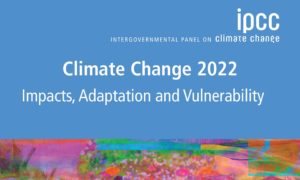Event Conference
COP26-COP27 Briefing on the IPCC Climate Change 2022 Report: Impacts, Adaptation & Vulnerability
The United Kingdom Permanent Mission to the United Nations Office and other international organizations in Geneva organized a COP26-COP27 Briefing on the IPCC Climate Change 2022 Report: Impacts, Adaptation & Vulnerability, with the support of the Geneva Environment Network.

About this Session
The new Working Group II report from the Intergovernmental Panel on Climate Change (IPCC) will provide policymakers with a clear view of the state and threat of global climate change. The latest climate science continues to reiterate that every fraction of a degree of warming spells more dangerous and costly consequences.
Following the Panel’s approval of the summary for policymakers, the COP26 Presidency and the designate COP27 Presidency are convening a briefing on the findings of the report to strengthen the global response for protecting communities on the frontlines of the climate crisis.
Speakers outlined how to take forward the progress made in Glasgow to COP27 in Sharm el-Sheikh, priorities for the global climate agenda in light of the new IPCC report, and practical steps the humanitarian, development, and other international communities can take to ensure we heed the warnings.
As COP26 President Alok Sharma stated in January, “Just as the science has become starker, the risks have become clearer, and the calls to action have grown louder, the opportunities presented by tackling climate change are increasingly evident.”
Speakers
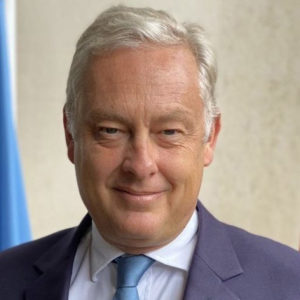
H.E. Amb. Simon MANLEY
Permanent Representative of the United Kingdom to the United Nations Office, WTO, and other international organizations in Geneva
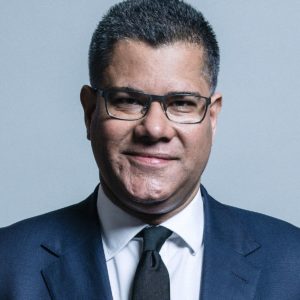
Rt. Hon. Alok SHARMA
UNFCCC COP26 President
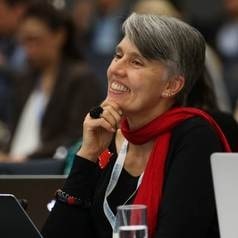
Debra ROBERTS
IPCC Working Group II Co-Chair

Rupa MUKERJI
Director, Advisory Services Helvetas, IPCC Lead Author

Archie YOUNG
UK Lead Climate Negotiator

H.E. Amb. Wael ABOULMAGD
Special Representative of COP27 President-designate

Jagan CHAPAGAIN
Secretary-General, International Federation of Red Cross and Red Crescent Societies (IFRC)
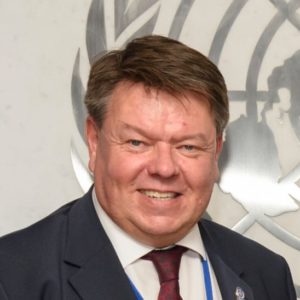
Prof. Petteri TAALAS
Secretary-General, World Meteorological Organization

Mami MIZUTORI
Special Representative of the Secretary-General for Disaster Risk Reduction
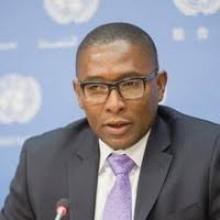
Selwin HART
Special Adviser and Assistant Secretary-General for Climate Action, United Nations

Nikki REISCH
Director, Climate and Energy Program, Center for International Environmental Law

Summary
Opening Remarks | H.E. Amb. Simon MANLEY
The achievements of COP26 were possible thanks to the collaboration of governments, civil society, business representatives and all those who participated. Despite the satisfying accomplishments, more needs to be done to keep climate change within the 1.5 C° target.
Briefing on the IPCC Report | Debra ROBERTS
The most important aspect of the IPCC Working Group II Report is that it forces us to take an honest look at ourselves as a species. Due to climate change, humans have curbed the planet, ecosystems that sustain our livelihoods, and the very infrastructure we depend on. The report and the unequivocal scientific evidence used send clear messages: “make no mistakes” and “there can be no dispute that climate change poses threats to human wellbeing and the health of the planet”. Additionally, the report sends an SOS call to public and private sector, as well as civil society that we only have a brief and rapidly closing window of opportunity to act.
The IPCC WG II shows that there is no region in the world that has not already been impacted by climate change in the shape of deteriorating ecosystems, losses and increasing damages and increasing challenges, especially for the most vulnerable. In many cases, this change is already irreversible. Exceeding the 1.5 C° level even for a short period of time will cause the extinction of species and losses of entire ecosystems such as mountain tops, coral reefs and coastal wetlands. The future beyond 1.5 C° will be characterized by increasing heatwaves, water scarcity, food insecurity, slides risks, diseases and increasing mental health challenges.
According to the IPCC assessment, current adaptation responses are in sufficient, as demonstrated by the significant implementation gap. Adaptation financing flows are also insufficient to tackle the challenges and funds are rarely spent where most needed, for instance, in informal settlements. On the other hand, adaptation cannot prevent all losses and economic and non-economic damages. As temperature increases, adaptation limits will be reached. Maladaptation can deteriorate things even more by aggravating already existing inequities.
So far, we are not on track for a climate-resilient world. How can this window of opportunity be seized? The following two options can allow sustainability vis-à-vis climate change. A move towards a more climate-resilient development would be facilitated by reducing climate risks through enhanced adaptation. Reducing greenhouse gas emissions through ambitious mitigation and increasing concerted efforts to achieve the Sustainable Development Goals (SDGs) is crucial. Actions addressing equity, injustice and inequality and empowering people would greatly enhance our reislience.
The report also points to the fact that cities are posing several challenges, but they also offer a global scale but time-limited opportunity to advance climate-resilient development, an integrated combination of mitigation, adaptation, conservation and ecosystem restoration, and sustainable development. These needed actions pose intrinsic challenges. However, the prospects of future options of a beyond 1.5 C° degree scenario would be even more challenging, and may simply not be possible if we exceed 2°C.
There is no doubt that international co-operation, political will and scaled up investment is key. The science is clear. Any further delay in concerted global action will miss the brief and rapidly closing window of opportunity to secure a liveable future. This report offers solutions to the world and a solutions framework in the form of climate-resilient development. I urge you to read it and to help stop the window firmly and permanently shutting in our faces and the faces of future generations The way forward is to help people around the world to live sustainably and with dignity – and in harmony with the planet that supports our lives and livelihoods.
Address from COP26 President | Rt. Hon. Alok SHARMA
For the past two years, calls to increase the attention given to adaptation have been persistent and the IPCC WGII Report is a stark demonstration of why it is urgently needed. The report highlights the world’s failure to take action on both mitigation and adaptation and portrays clearly the scenario of what inaction will entail. Climate change impacts are coming faster and more fiercely than predicted, and the report shows what has already been lost. Adaptation has clearly reached its limits: ecosystems are irreversibly damaged and half of humanity is already vulnerable to climate change. Still, this is a threat that regards every nation and every person on earth.
Hazards traverse borders, they compound one another, and they cut across different sectors of the economy. And unless we act collectively, the IPCC is clear, within our lifetimes the impacts will grow in force and ferocity to, frankly, terrifying levels.
But we have a choice here. That is another clear message from the report. The future is not written. The change that comes about is within our control. We know how to build a more climate resilient society. How to protect people, economies and ecosystems. But we must act much faster to close the gap between need and action.
The UNFCCC, the Paris Agreement and now the Glasgow Climate Pact represent the framework for scaling up climate action and adaptation support. It urges party to further scale adaptation to national, regional and local to integrated planning, and it urges developed countries to double climate finance for adaptation from 2019 levels to 2025. At COP26 the Glasgow-Sharm-el Sheik work programme was launched to deliver on the global goal of adaptation. It aims to achieve this goal by protecting people from the adverse impacts of climate change, for instance through the limitation of the rise in global temperatures. As temperatures rise, adaptation becomes harder, as the IPCC firmly states by pressuring us to limit the rise to the 1.5 C° level. Honoring the Glasgow Climate pact means keeping the 1.5 C° goal alive, reducing the emissions by 2030, achieving the Sustainable Development Goals, phasing out coal power and fossil fuels. Nevertheless, if 1.5° are reached, adaptation will have its limits and it will require also dealing with loss and damage. The Glasgow Climate Pact makes real progress in terms of loss and damage, including providing technical support to the Santiago Network and establishing the Glasgow Dialogue to discuss funding arrangements.
The commitments made in Glasgow are historic but now are only words on a page: the goal that must be achieved this year is delivery, turning words into action. The UK is ready to collaborate with Egypt to deliver on all commitments related to adaptation, loss and damage and to put all countries on track to respect the Glasgow Pact. All efforts must be devoted to making commitments into concrete plans and actions, therefore we are working with donor countries to double adaptation finance and with the global community to ensure the achievement of the global goal of adaptation. Moreover, the UK is working to ensure the Glasgow Dialogue results in practical progress as increased funding for loss and damages. By COP27, the global community must have developed a clear proposal and funding for the Santiago Network.
The science is clear. We know what we have lost. We know what is coming. We know that the window of opportunity to act is closing fast. Inaction is not an option. We cannot fail to prepare.
Panel Discussion with Reflections from Speakers
Reflections from the COP26 Presidency | Archie YOUNG
The IPCC report stresses both long-term and short-term risks and hazards to be addressed. Considering the harder impact risks posed to the most vulnerable, it is fundamental to keep the focus on the human dimension of actions. Meanwhile, the technical aspect must be grounded in scientific data, as emphasized in the very first section of the Glasgow Climate Pact. The crucial importance of adaptation, loss and damage highlighted in the IPCC Report is echoed in the priorities of COP26 and of COP27 as well. Among all the commitments made in Glasgow, making sure that science comes first and welcoming the work of the IPCC is one of the potentially longest-standing commitments delivered to the international community. The Glasgow Pact indeed invites the IPCC to present the results of WGII to COP27.
All past climate pacts are important, but they need to be followed through. We need to make sure that the transition from Glasgow to Sharm El-Sheik will lead to tangible adaptation outcomes by stepping up funding and action.
The achievements made by COP26, like the doubling of the adaptation funding, the Glasgow Dialogue on loss and damage and the work on the Santiago Network, all need to be followed through. This entails for instance not only collecting the money but also allocating it where most needed, including toward locally-led and community-based adaptation. Other focus areas are being already implemented through programs, programs reforms and systems that ensure that people who are hit the hardest are provided what they need.
We recognize that Glasgow did not meet everybody’s expectations on some of these issues, leaving a lot to be done by the Egyptian Presidency. UK will continue bringing the work forward to ensure the Glasgow-Sharm-el Sheik Work Programme on the global goal on adaptation leads to tangible differences in adaptation action aound the world. The UK also wishes to make sure that the Glasgow Dialogue makes it possible to step up the fundings to advert and minimize loss and damage. The UK has been continously working on these goals. This is not the work of one country or one orgnaization: all of us together need to coordinate, use the best expertise, ground our actions, push for more ambition and accelerate implementation.
Reflections from the COP27 Presidency | H.E. Amb. Wael ABOULMAGD
Glasgow has achieved fantastic targets and agreements, but much more needs to be done to ensure implementation. Most of the negotiating work is concluded, but the world is awaiting tangible, visible impacts on the ground. Egypt agrees on the importance of adaptation, as highlighted by the UK and the IPCC Report, and is indeed working to ensure the latest scientific findings are at the core of its work.
More specifically, Egypt wished to include the key messages of the IPCC report and their supporting scientific evidence in the work of the UNFCCC. Climate change has already caused damaged and irreversible losses to ecosystems. When climate change impacts areas with high vulnerabilities, it contributes to humanitarian crises and increasingly drives displacement. Climate-related effects have brought many into food and water insecurity, especially in Africa, Central Asia, South America, small islands and the Arctic.
Various UNEP reports underline the gaps and needs in adaptation funding in developing countries. According to the UNEP Gap Report 2021, adaptation for developing countries amounts to 70 billion USD annually and is expected to reach 300 billion by 2030 and 500 billion in 2050. However, the needed sums are significantly higher than these estimates. This is confirmed by the IPCC WG II report : an overwhelming majority of global climate finance has so far been targeted by climate change mitigation. Current public and private financial flows to adaptation are much smaller than needed, with only 4 to 8 % of climate finance is actually going to adaptation efforts in recent years. The pledge to double adaptation funding made in Glasgow is a step in the right direction, but it still falls short of actual needs.
At COP27, the world is expecting bolder commitments informed by the IPCC Working Group II Report’s findings to increase adaptation funding beyond doubling, with a clear delivery plan, simplified access modalities, and through instruments that do not drive further debt. While we acknowledge that these needs cannot be met through finance from developed countries alone, we need to see how public finance can unlock and de-risk private investment in adaptation projects in developing countries. This requires a creative and innovative approach to finance and demonstration of goodwill by all to operationalize equity, justice, common but differentiated responsibilities and respective capabilities (CBDR) and leave no one behind to suffer irreversible impacts.
Going forwards in this decade of implementation, the COP27 Presidency believes in the centrality of the role of the UNFCCC to address the adaptation fragmentation and the implementation gap at the global level. Parties at COP26 successfully established the key processes allowing for these to progress through the Sharm-el Sheik Work Program on the Global Goal on Adaptation (GGA) and the deliberation on a New Collective Quantified Finance Goal.
The Egypt Presidency is committed to facilitating a Party-driven process aimed at defining and achieving the global goal on adaptation, and to ensure a correct adaptation response in light of the mitigation ambitions and informed by the IPCC’s recent findings. At the consultations held in February on the urgency of adaptation, Parties affirmed loudly and clearly their wishes and Egypt takes this to heart and will respond with a clear plan on all aspects of implementation.
We can only collectively succeed and deal with the challenges of climate change if we develop and nurture a sense of trust and mutual understanding amongst all parties. Many have repeated we are all in the same boat to the extent of becoming a cliché. However, it is true that success depends on every Party’s seeing and believing that their interest and priorities are taken on board.
No one should feel abandoned or left behind and this requires listening carefully to each other and at least trying to empathize with the concerns and challenges of others. Conversely, achieving the progress we all need without empathy and understanding will be hard. It is thus important to remember that the multilateral climate change platform is a fragile one. The Paris Agreement highly depended on the buy-in of all Parties for success and their genuine commitment and willingness to contribute in good faith to the global effort. This buy-in will be jeopardized if countries, especially from the Global South, feel that their needs are being side-lined or that they are being called upon to carry a heavier burden than can be brought, without being provided need assurances that climate finance is available and accessible to assist them in delivering on their contributions to global efforts.
Humanitarian Implications of the Report | Jagan CHAPAGAIN
The conclusions of the IPCC report was not a surprise to us. We have been hearing this from our communities, our volunteers on the ground, from the countries who have been affected and who have been listening to big talks globally but have not seen the real action on the ground for far too long. In many ways, the report validates this reality with concrete scienceDoubters now have no reason to doubt as there is a solid scientific basis behind what we have been hearing and what we have been feeling before. From that point of view, the findings and outcomes of this IPCC report are really invaluable.
The report acknowledges that there are certainly limits to adaptation and that we can’t prevent all losses and damages. However, the poorest and most vulnerable will bear the greatest losses – and that should not have to be the case.
In many cases, adaptation options do exist but are not available because of lack of finance, capacity, determination, or a conducive policy environment. This is where the Glasgow Dialogue and Santiago Network as outcomes of the COP26 will be important next steps to scale up practical action for averting, minimizing and addressing loss and damage. In particular, disaster management systems must become even more anticipatory. Instead of responding after a shock has hit, these systems are now responding to forecasts to enable early action, to enable faster and better response, and in some cases to prevent losses altogether. But these need to be available in more communities, for different types of hazards, and at a much greater scale.
What is most important about this report is the action that it follows. Activists and people living in some of these highly vulnerable communities express frustrations about the lack of action. Therefore, we must find a way to turn these scientific findings into commitments for concrete action on the ground that changes the reality. Far too many people have not felt that. This does not mean to say nothing is happening but that is not happening at the scale required to make a difference.
The IFRC, as a membership organization representing 192 countries with more than 14 million volunteers working at the community level, is using its own experience, knowledge, and the findings from the IPCC report, to try to change action at the local and community levels. IFRC has been working to mobilize our membership to raise roughly 250 million people by 2025 with the locally-led climate action on the ground. Locally-led initiative are essential to connect the work of local authorities and national governments to the global commitments made in Glasgow and other fora. Such initiatives will focus on climate resilience and adaptation but also on anticipatory actions to really make a difference in people’s lives.
In parallel, we are committed to changing our own organizational practices. All IFRC’s programs, behaviors, offices, logistics, fleets also need to adapt : it is not only about lecturing others but also about changing ourselves. One example developed in collaboration with the Red Cross Education Movement and other organizations such as UN agencies and NGOs is the Climate and Environment Charter. The charter aims to rally the humanitarian sector efforts into a more coordinated and integrated response to the climate crisis. In less than a year, more than 220 organizations have signed the Charter. The governments of Switzerland, Norway and the United States are joined, despite it not being originally intended for governments to sign. The Charter itself is not a big achievement, but if it rallies the humanities sector together it will have a big influence as humanitarians do have the capacity to make an impact on climate.
Finally, we need to focus on the gap between the two COP events, where often not enough happens. In Glasgow, there were moments when people were very enthusiastic and sometimes shouting, sloganeering and others where people are having a serious negotiation and the two were not necessarily connected. The first kind of moments is helpful for bringing the voices of the communities and affected people to the negotiating table. Therefore, it is important to keep these dialogues alive from now Glasgow to Egypt through events like today’s. In this perspective, the IFCR together with the Egyptian and UK Missions will be hosting Climate Science Humanitarian Dialogue later in March in Geneva. It aims to keep the dialogue going on and to bring in the voices of this neighbor community, building on what is discussed today to influence the outcome in COP27.
State of the climate, reflections from WMO | Prof. Petteri TAALAS
We must pay attention to adaptation and mitigation. We must continue investing in basic observing systems and fill in data gaps. It’s going to take all UN agencies.
At the UN level, Glasgow is regarded as the second most successful COP meeting so far, following the groundbreaking achievements made in Paris. In Glasgow, 80 % of the goals were met, yet we are not fully on the track towards the 1.5 C° target. Still, positive signs are coming from G7 countries and the European Union and hoping the Egyptian and then the Arabian Emirates Presidencies will overcome the challenge of replicating these pledges at the G20 country level.
The strong messages sent by the heads of States in Glasgow and the onboarding of many governments to tackle climate change demonstrate a shift in mentality towards climate change. Still, we are not yet heading towards the Paris limit of 1.5 C°, rather towards a 2.5 to 3 C°. This is already an improvement considering the 2014 IPCC Report predicted a 3 to 5 C° peak by the end of this century. Already 32 countries reduced their emissions during the past 15 years, headed by Denmark and the UK. The most pressing question is how to raise this level of ambition to G20 countries. The G7 and European Union are responsible for one-third of the emissions and almost half of the emissions come from the rest of the G20. The recent IPCC reports and WMO reports cleary highlighted these messages.
On the other hand, during the past 20 years, 40% of the population worldwide has faced major natural disasters; 2 billion people faced flooding events; 1.5 billion experienced drought events, and 700 million tropical storm events. Temperate records are continuously being broken in terms of temperature as 48.8 degrees were reached in Southern Italy, 49.4 C° degrees in Western Canada, often causing forest fires.
Besides climate mitigation, it is also important to pay attention to population growth. If we would only be one billion on this planet, we would not be facing climate change problems. Urbanization is making this challenge even more urgent: the risks related to economics, health, ecosystems, infrastructures and so forth were pinpointed by the IPCC report. Many of these are related to global warming, flooding, droughts and melting of glaciers. This is why WMO started paying attention to the water-climate nexus and established the Center for Excellence on Disasters and Climate Change together with the UN Office for Disaster Risk Reduction.
We should keep in mind that this negative trend in climate will continue for the coming decades no matter what, and that means adaptation is central. The 400 ppm level of carbon dioxide has already been broken, meaning that the melting of glaciers and sea-level rise will continue for the coming centuries. Overshooting the 400 ppm level means that the sea level could be 10 to 30 meters higher than today, with dramatic impacts on many cities on coastlines.
From WMO perspective, investments in early warning services is a very powerful way to adapt to climate change. Only half of the 193 WMO members have proper early warning services and we have major gaps in the observing systems in Africa, the Caribbean and the Pacific Islands. To cope with these, WMO created a financing mechanism called Systematic Observations Finance Facility (SOFF)v to invest in basic observing systems. Another gap is represented by the limited understanding of how carbon dioxide and methane are behaving, requiring more investments to understand those issues.
Disaster risk response, reflections from UNDRR | Mami MIZUTORI
Already in the first three months in 2022, many extreme weather events occurred all over the world. As stated by the IPCC Report, there is no single place on earth that is safe from such phenomena. The report is a serious reminder of how stark the current climate situation is and how precarious the future is if action is not taken now. The UN Disaster Risk Reduction agency deals for mostly situations related to extreme weather events, making the climate emergency the core of UNDRR work. UNDRR shared three key messages in Glasgow:
- Enhance climate adaptation;
- Increase support to minimize, avert and address losses and damages;
- Enhance predictability in financing.
These three must be understood on a full spectrum understanding of risk. If action is not risk-informed, none of these will work. It is therefore a good sign that adaptation and resilience will be taken forward very energetically at COP27 in Sharm-el Sheikh. The IPCC report tells us that there are limits to adaptation while providing clear evidence-based findings. Therefore, it should really be the basis of our future thinking on policy.
The IPCC report tells us that there are limits to adaptation, but it also offers solutions. If we can combine disaster risk reduction with social protection, we can correct course. There are solutions available in spite of the limits.
The IPCC report does offer solutions despite all the dire things that it portrays. Among these, the report discusses the danger of maladaptation and pushes us to reflect on how it can be avoided, and the DRR aspect comes in first. It is important to ensure that the National Adaptation Plans (NAPs) consider all risk drivers. When climate risks are combined and enhanced by poverty, by inequality, by environmental risk, hazards become tremendous disasters. In order to avoid maladaptation, NAPs need to be risk-informed and consider all possible DRR measures.
At the same time, the DRR national strategies that all Member States need to have under the Sendai Framework evidently need to look at climate risk. In many countries, authorities working on climate policy and those dealing with DRR are not talking to each other and that contributes to the creation of silos around adaptation policies and DRR strategies. This lack of coordination is a barrier to sustainable development.
The first way to avoid maladaptation is to combine climate and DRR globally, regionally and nationally. At the global level, UNDRR and WMO recently launched the Center of Excellence for Climate and Disaster Resilience, already joined by more than 10 UN agencies like UNDP, UNFCCC and FAO. The Center aims to create knowledge products for Member States on how the nexus between climate and DRR, how to combine these for better governance and how to develop early warning and early action.
The second thing that we need to do to avoid maladaptation is to support more substantively all Member States, especially those who are in vulnerable situations, including SIDS and LDCS. In this regard, we need to follow what has been achieved at COP26 with the Santiago Network, dedicated to enhancing technical support to Member States for reducing their losses in damages. The Santiago Network requires contributions to bringing together all the knowledge and experience within the UN system and beyond, so that further losses in damages can be reduced as much as possible. Right now we are in this very important process and this needs to be launched at COP27.
The third way to avoid maladaptation is financing the missing piece in climate and disaster risk financing. There is just not enough money going into climate and DRR, while many countries urgently need investment in this area. It is necessary to build on the agreement that was reached at Glasgow to finance for climate change adaptation and double that. Moreover, we need to recognize that each dollar that is withheld, means someone’s life is on the line. It is also important that we reach the 100 billion for climate finance with 50% going to mitigation and 50% to adaptation. ODA and banks should only invest in sustainable infrastructure that is climate-resilient and in line with a low carbon future. Companies need to comprehensively report their climate exposure, both in terms of their contribution to global emission and of the risk in their portfolios based on negative climate change impact. We also urgently need to create a new market structure to finance the climate transition in developing countries and we need to incentivize climate-resilient investment through structures, including green bonds and preferential financing.
In conclusion, we need to keep the dialogue going. In between COP26 and COP27 the Indonesian Government is going to host the Global Platform for Disaster Risk Reduction in May in Bali. There will be a lot of focus on climate and be a ministerial roundtable around climate. Also, these discussions on the synergy between climate and DRR will be important for governments and non-governmental stakeholders. We sincerely hope that this can be a bridge between Glasgow and Sharm-el Sheik for building resilience and helping us get out from this vicious circle of disaster reduction-response-recovery and then disaster again.
Reflections from an IPCC Lead Author | Rupa MUKERJI
All lead authors of IPCC WGII have contributed their time voluntary over the last four years to this very difficult work and collaboration conditions under COVID-19 restrictions. This assessment report took a big step by using of an integrative and holistic approach to assess vulnerability and climate risk. The report highlights certain global hot spots where overlapping challenges such as high levels of poverty, limited access to basic services, weak leadership, reduced trust in government combined to heighten vulnerability and climate change. Indeed, this is how climate change impacts are felt: it combines with existing vulnerabilities and affects communities who have low development levels the first and the highest. The loss of lives from floods droughts and storms in the last decade has been 15 times higher in these hot spots than in more resilient countries.
Currently, 3.3 billion people across Central and South America, Africa, South Asia, SIDS and the Arctic are considered highly vulnerable to climate change. Half the world’s population already experiences water insecurity for at least a month each year due to climate combining with other factors. These are the hot spots we should be conscious about in targeting our interventions.
A warming of 1.5°C and consequent lack of freshwater could mean that people living in SIDS and those dependent on glaciers and snowmelt can no longer adapt. The report assesses adaptation options and limits to adaptation with different degrees of warming and it highlights that these regions could experience a 50% decline in water supply for agriculture and hydropower, which is actually one of the very important mitigation measures.
Climate change will also increasingly undermine food security: we depend on a small range of crops that have been bred specifically for very precise temperature and moisture and precipitation levels. Therefore, by 2°C warming yields, of multiple staple crops will be adversely affected. People in Sub-Saharan Africa, South Asia, Central America and the SIDS are likely to experience food shortages leading to malnutrition.
Gloally, more than a billion people living in low-lying cities and other settlements on the coast are projected to be at risk of sea-level rise and other climate hazards by 2050. The report clearly presents that children born today are likely to experience a very different climate by the time they are adults. The time horizon for action get shorter and shorter. This assessment also highlights that adaptation efforts have increased but the progress remains uneven as there these efforts are fragmented. Current actions are often inadequate to deal with current levels of warming. Therefore, we are hardly prepared to deal with the form of warming that is inbuilt into the system and that we are likely to experience by 2040. The gaps between adaptation needs and actions are widening especially in lower-income countries affecting populations who are already vulnerable and have limited capacities. Future vulnerabilities will also be concentrated in places where the capacity of governments, communities and the private sector to provide basic services is constrained. Thus, development and DRR actors should be particularly attentive to these needs.
Reflections from the United Nations Secretariat | Selwin HART
The lack of scientific understanding of the consequences of inaction or insufficient action to address the climate crisis is no longer a legitimate excuse. Based on what was claimed today and written in the report, we are now at a critical moment and running out of time to reverse course and prevent the worst impacts of the climate crisis. The good news is that we now know with certainty what needs to be done, over what time frame and what are the critical thresholds we dare not cross. According to the report, we have two urgent tasks ahead of us. First, we must reduce emissions in line with the 1.5 C° goal and second, we must invest in adaptation and resilience to save and protect lives and livelihoods. The IPCC report shows that the frequency and intensity of climate impacts are accelerating already at a 1.1 – 1.2 C° warming above pre-industrial levels and previews further catastrophe for humanity and the planet if we breach the 1.5 C° goal.
Science tells us that this will require the world to cut emissions by 45% below 2010 levels by 2030. However, according to the current commitments that were submitted at Glasgow, global emissions are set to increase by almost 14 % during this decade. By any measure, the world is way off course. The G20 nations account for 80 % of global emissions and their leadership is needed more than ever. As the Secretary General stated, coal and other fossil fuels are choking humanity making ending coal in OECD countries by 2030 and before 2040 in the rest of the world the single most important step that can be taken to keep 1.5 C° target alive. The pressing development priorities of developing countries are known to be requiring financial and technological support to accelerate their transition away from coal and other fossil fuels to renewable energy. This is the reason why the Secretary General continues to call on developed countries, multilateral development banks (MDBs), private financiers and others to form coalitions to help emerging economies end the use of coal. These targeted mechanisms of support would be over and above existing sustainable development needs.
The second urgent action must be to give adaptation and resilience support the same priority as mitigation. After close to three decades of intergovernmental negotiations on climate, adaptation finance received just a mere 25% or 20 billion of total climate finance in 2019. The IPCC report clearly illustrates that a lack of support for adaptation is already costing lives in vulnerable regions and communities. Living in one of the global hot spots identified in this report means being 15 times more likely to die from a climate impact. Despite the major advances that we have made in technologies over the last three decades, one-third of the world’s population is still not covered by early warning systems, which are known to save lives.
The commitment made in the Glasgow Climate Pact to double adaptation finance, if delivered, is a step in the right direction but it is not enough. It is necessary to urgently address the challenges faced by vulnerable countries in accessing climate finance. As the Secretary General said last week, money that cannot be accessed is the same as money not being provided at all. We must therefore pursue with urgency the promises made at Glasgow to remove the obstacles that prevent SIDS, LDCs and other vulnerable countries from getting the finance they desperately need to save lives and livelihoods. This includes reviewing current and at times outdated eligibility systems that only focus on per capita income.
Our window of opportunity to prevent the worst impacts of the climate crisis is almost closed. When the next assessment report will be finalized in the next five to six years we might already be too late if we do not take the required actions now to urgently reduce emissions and invest in adaptation and resilience in the coming years. This will require the transformation of economies and societies and the mobilization of trillions in private and public finance. It will also require the inclusion of private and public finance, private sector, civil society, including young people who are increasingly facing an uncertain future. Finally, let’s thank the brave and hard-working scientists behind this report and pass reports for doing your job and for alerting all of us on the threat posed by the climate crisis. It is now up to governments to act on that closing window as we still have a narrow opportunity to prevent the worst impacts of climate change.
Reflections from Civil Society | Nikki REISCH
The current situation in Ukraine is a tragic reminder of the intersections between fossil fuel resources and violent conflict, and of the urgent need to end the world’s reliance on coal, oil, gas and all fossil fuels. Doing so is necessary for peace and for the planet. The IPCC report highlights key warnings that echo what civil society, local communities, and indigenous peoples have been saying for years. It acknowledges the central role of justice, equity and inclusive governance in effective climate action on adaptation mitigation and loss and damage. These observations and messages must give rise to concrete action between now and COP27 and well beyond.
A critical point raised in the IPCC Report regards overshooting, claiming it would pose grave dangers and unleash irreversible impacts for centuries and even millennia. We know that surpassing 1.5 C° even temporarily will cause irreversible damage to human and natural systems, such as loss of life, land, ice, entire ecosystems and the livelihoods depending on them. Thwarting adaptation, policy responses and mitigation measures must be science-based and designed to avoid overshoot. Immediate action to reduce emissions taken in this decade, through an immediate halt to oil and gas expansion and a phase-out of the production and use of all fossil fuels, is decisive for both emissions reductions in mitigation measures and for adaptation. Near-term action is simply essential to avoid the additional loss and damage that would ensue if a 1.5 C° warming is reached and the irreparable harm unleashed through overshooting.
Policy choices that lock the world into overshooting 1.5°C and gambling on return, rather than immediately and drastically slashing emissions— including through rapid phaseout of fossil fuel production and use and a halt to deforestation— invite permanent loss and irreversible damage to humans and ecosystems around the world. In the face of this latest IPCC report, such choices are indefensible.
Technological approaches deployed to reverse or mask overshoot such as solar radiation, modification, or carbon dioxide removal, could not only prove ineffective but further risk additional harm and disasters like rainfall disruption, termination shock, and erosion of human ecological resilience. These points raised in the IPCC’s Report underscore the absolute imperative to prioritize near-term reductions and actions that will avoid as much as possible reaching or exceeding 1.5 C°, rather than relying on risky technologies.
Another aspect civil society is very invested in is the absolute necessity for delivering action on loss and damage. That action needs to take the form of financing the most vulnerable communities, who are the least responsible for the current crisis and yest the hardest hit. The IPCC report affirms that governments are failing populations least responsible and that redress for those harms is not just a moral imperative, but an obligation under international law. This aspect should provide a light of fire for States going into COP27 to move beyond what was agreed in Glasgow and deliver funding for loss and damage, while phasing out fossil fuels to prevent global temperature rise from exceeding 1.5 C°.
Finally, the critical recognition reflected in the report regards the central necessity of inclusive decision-making on climate, centering equity, justice, indigenous peoples and traditional knowledge in climate action. The report stresses with unprecedented emphasis that participation and those sources of knowledge and engagement in locally-driven climate action are necessary for effective adaptation and climate-resilient development. Therefore, it is imperative from the perspective of civil society that public participation be addressed effectively both in the process leading up to the COP, and during the COP through meaningful engagement of civil society and indigenous peoples. Moreover, the decisions adopted at COP and throughout this year, need to provide strong mandates to support and enhance community-based and participatory responses to adaptation and loss and damage, essential for effective climate action and justice. Therefore, governments, members of civil society, the private sector must cooperate to realize the near-term immediate efforts needed to avoid overshoot and to center human rights and people-based solutions without which no effective climate is possible.
Q&A
Q / Reflection (Permanent Representative of the Netherlands): First, building on what was said by panelists, adaptation is crucial and must go hand in hand with mitigation. Echoing Alok Sharma, failure is not an option. The Netherlands is aware and takes responsibility to achieve adaptation goals as demonstrated by the Climate Adaption summary in January 2021.
The Egyptian leadership on COP27 is to be praised because, among other things, Egypt recognizes the importance of water and all related phenomena. COP27 will be followed by UN 2023 Water Conference in New York, co-hosted by the Netherlands and Tajikistan, where all people, from every stratum of society, are invited to take part in the aim of scaling up funding, actions, best practices and innovations to put the whole world on track for the achievement of SDG 6 (clean water and sanitation for all). Is there any support from the panel towards this conference and this Goal?
Q from Permanent Representative of Slovenia: The impact of climate change on water resources is the most visible one. Some areas of action can intake :
- integrating the climate and water agendas both at the national levels and to transboundary and water cooperation management;
- adopting nature-based solutions as part of adaptation, resilience and mitigation efforts;
- spreading and ensuring open access to reliable data on climate and water to inform effective policy;
- nominating a UN Special Envoy for Water;
- cooperation among actors to further promote the water-climate nexus, as WMO Climate and Water Coalition and the UK Government are already doing.
Petteri TAALAS: In relation to the water-climate nexus, WMO is hosting on 8 March a high-level panel to give a boost to global water management systems and credit services.
H.E. Amb. Wael ABOULMAGD: In 2019, in the build-up of the Climate Action Summit, Egypt and UK partnered with the Netherlands in the Adaptation Track. This is an auspicious sign that this collaboration will continue further, and that the UK will be taking steps to carry the Adaptation Agenda forward.
Q: Can you provide some concrete examples of maladaptation previously and currently implemented, especially in developing countries?
Rupa MUKERJI : 60 % of adaptation responses deal with water. Some of them are also maladaptive for instance, building floodwalls, which can give a sense of false security, drawing in populations into areas where risks are high, become a risk-enhancing source rather than a protection. Again, investments in irrigation made without accounting for changing precipitation patterns.
Q: Climate adaptation is fundamental but it requires workers to develop new skills, change occupations, ways of operating and ensure occupational safety. Social security and policy must play a role in mitigation and adaptation as was shown by the Just Transition Declaration at COP26 and the UN Secretary General Global Accelerator for Jobs and Social Protection initiative. There are ways to align climate mitigation and adaptation with social policies, but currently, there is a gap since none of the existing funding mechanisms makes it possible to deal with these social policies. What could be done to economically these social policies?
Q to the UK Presidency Archie YOUNG: The climate 1.5 C° target is to be solved in the G20 formation, inclusive of China and India. The media exposed that these two countries exercised pressure to change the language for the Glasgow quote and now about the just transition pact in South Africa. Is there anything in the making that help those countries, both politically and on the ground to enact a just transition?
Archie YOUNG: The collaboration of governments, industries, donors to make packages to respond to specific circumstances related to the just transition. This transition is unprecedented and therefore it is crucial to ensure to take people with us. The representation of civil society at COP26 surpassed any previous ones but their voices still need to be amplified.
Indeed, the 10-years program on Climate Empowerment agreed on at COP26 did not get much attention, but it is a fundamental step to ensure public awareness, education and empowerment on climate change, particularly youth and women. Paragraph 95 from the Glasgow Climate Pact encourages parties to increase the full and meaningful participation of women in decisions, implementation and means of implementation. This translated into the advancement of gender-responsive finance and the Gender Action Plan.
Petteri TAALAS: The BRICS countries (Brazil, Russia, India, China and South Africa) are very sensitive to climate change impacts and thus have very good reasons to be part of the adaptation front.
Q : Taking the example of the floods in Germany in 2021, it is clear that Germany does not need funds for climate adaptation, planning or early disaster because the national government spend millions a year on it, but vulnerable countries do. Are there impactful solutions to reduce the gap in adaptation capabilities between developing and developed countries planned by COP27?
Selwin HART: Based on where one lives, the likelihood of dying from a climate-related impact varies enormously. Therefore, countries that are more exposed to these risks need to be the recipients of investments for adaptation and resilience. In the immediate future, public sector finance will have to pay the bulk of it while private finance will require more leverage. Finally, we cannot give up hope, we look forward to continuing working in global cooperation.
Mami MIZUTORI: The issue is not only in developing countries where climate financing for adaptation is insufficient but also in developed ones. Looking at the budget, only small sums of the money goes into prevention/ adaptation and disaster risk reduction and this is related to the perception of it as a cost rather than as an investment. Unless the mindset that investing in these aspects is an investment and not a cost things will remain as they are, and such change is needed both in ODA and domestic budgets.
Petteri TAALAS: At the national level is important that hydrological and meteorological organizations work together, and the lack of cooperation has demonstrated to be fatal in the case of floods in Germany in 2021.
Q: Relating to the mentioned importance of trust in achieving implementation and the 1.5 C° target, how will the COP27 presidency ensure a fairer balance among stakeholders, given the over representations of fossil fuel companies at COP26?
Archie Young: UNFCCC is a consensus-based process, 196 countries need to agree, and the fact countries agreed to fossil fuel-related decisions shows the collective will to move forward on the climate agenda. Countries have particular sensitivities and that might be the case for China and India. Nevertheless, it must be noticed that these countries are also taking massive action to reduce their climate footprint: China overtook the UK last year with the off-shore wind capacity, India has committed to 420 Giga-Watts of renewables. These impressive achievements need to be articulated and overtaken at the level of Nationally- Determined Contributions (NDCs) so that fossil fuel dependency slows down under this collective effort made of tangible policies on the ground.
H.E. Amb. Wael ABOULMAGD: The Egyptian Presidency recognized that the actions taken concerning climate change are the most consequential ones in this historical moment. It is essential that intentions are reflected in the negotiating room and that we genuinely show empathy to developing countries, as a demonstration of efforts to the best of our capacities to address climate change with equity. Government Representatives will be seeking their national interest by trying to reduce commitments they take upon themselves and maximize gains from multilateral processes, but given the importance of these negotiations, hopefully, there will be more room for mutual listening, appreciation of other countries’ actions to confront their challenges. Egypt as a chair wishes to provide the format and the venue for people to come together and make the necessary concessions.
Q: This year’s theme for International Women’s Day is “Gender Equality for a Sustainable Tomorrow” and it was chosen because this year’s Commission on the Status of Women, the primary UN body for gender equality and empowerment of women also deals with these themes. The main recommendations coming from SDG Monitoring Report “Gender Equality in the 2030 Agenda for Sustainable Development” are:
- to systematically integrate gender perspectives into policies and programs in climate change, environment and disaster risk reduction.
- to promote the leadership of women
- strengthen the capacities of women and women’s organizations to build climate environmental and disaster resilience
- look at increasing gender-responsive finance, including for women’s organizations and their communities
- look at gender-disaggregated statistics in the gender-environment nexus
- increases of gender-based violence, in insecurity for women and girls in contexts of climatic impacts and displacements.
These recommendations are highly relevant to what was discussed today in terms of the need to reinforce adaptation funds.
To what extent does the IPCC Working Group II Report look at specific impacts on women and girls? To what extent in our work around the adaptation funds and the global goals is the need for a gender-responsive response considered?
Conclusion
Video
In addition to the live WebEx and YouTube transmissions, the video is available on this webpage.
Documents
- Climate Change 2022: Impacts, Adaptation and Vulnerability | IPCC Working Group II contribution to the Sixth Assessment Report
- Joint Statement UK-Egypt-UNFCCC | Response to IPCC Working Group 2 Report | 28 February 2022
- WMO News Article on the event | 7 March 2022
Links
- 26th UN Climate Change Conference of the Parties (COP26)
- Intergovernmental Panel on Climate Change (IPCC)
- Climate change: a threat to human wellbeing and health of the planet. Taking action now can secure our future | IPCC Press release | 28 February 2022
- New IPCC Report Confirms Increasing and Irreversible Damage from Climate Impacts & Intolerable Risks of Overshooting 1.5°C | CIEL | 28 February 2022
- Beyond the Limits: New IPCC WG II Report Highlights How Gambling on Overshoot is Pushing the Planet Past a Point of No Return | CIEL | February 2022

